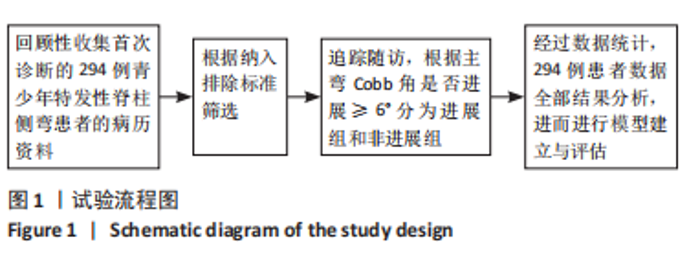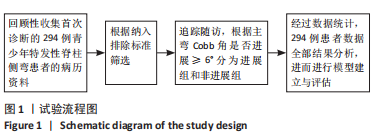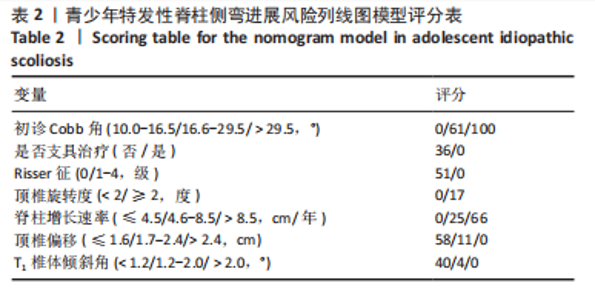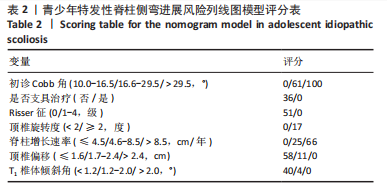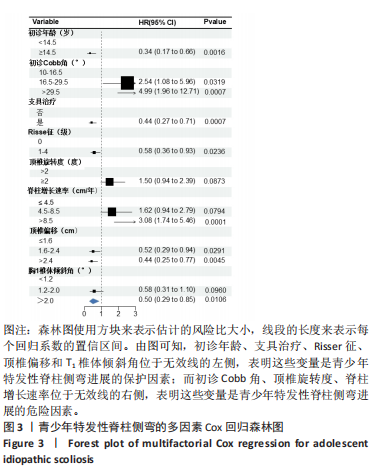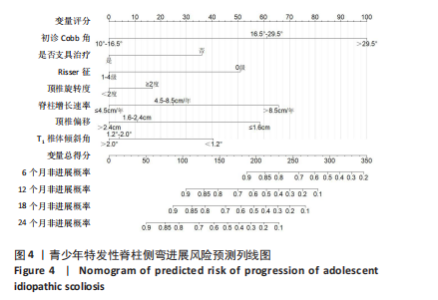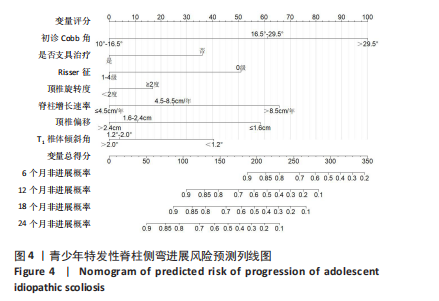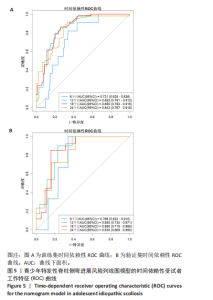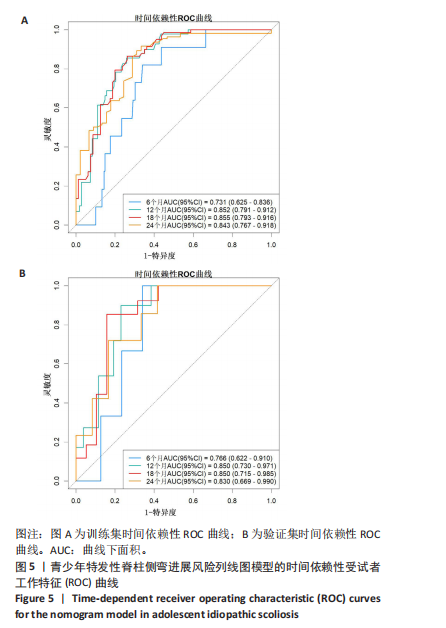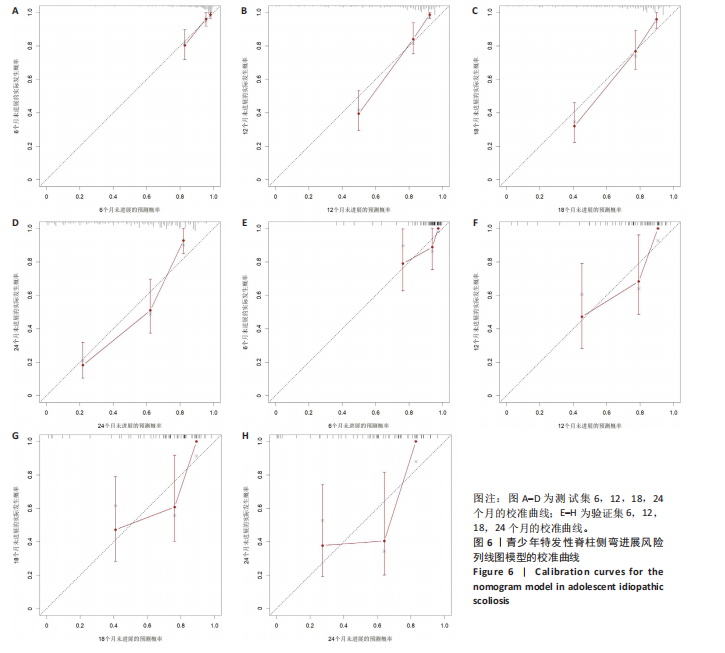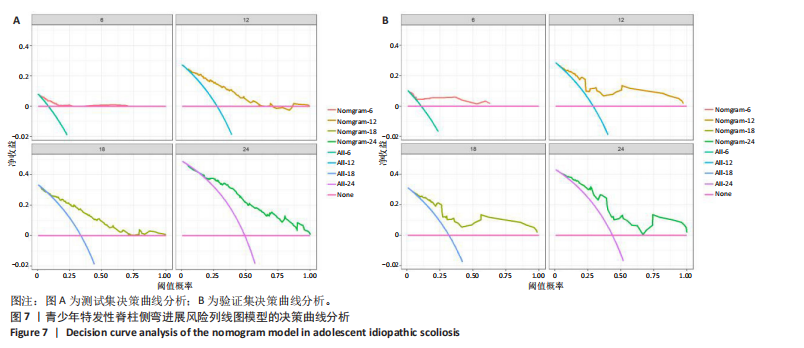Chinese Journal of Tissue Engineering Research ›› 2026, Vol. 30 ›› Issue (11): 2727-2735.doi: 10.12307/2026.102
Previous Articles Next Articles
Influencing factors of spine deformity progression in adolescent idiopathic scoliosis and construction of a joint prediction model and nomogram
Li Jie1, 2, Zhao Xiaofeng3, Zeng Qi1, 2, Zhou Runtian3, Chen Rong1, Hu Xijian3, Zhao Bin3
- 1Academy of Medical Sciences, Shanxi Medical University, Taiyuan 030001, Shanxi Province, China; 2Department of Epidemiology, School of Public Health, Shanxi Medical University, Taiyuan 030001, Shanxi Province, China; 3Department of Orthopedics, The Second Hospital of Shanxi Medical University, Taiyuan 030001, Shanxi Province, China
-
Received:2025-04-03Accepted:2025-06-05Online:2026-04-18Published:2025-09-05 -
Contact:Zhao Bin, MD, Chief physician, Department of Orthopedics, The Second Hospital of Shanxi Medical University, Taiyuan 030001, Shanxi Province, China -
About author:Li Jie, MS candidate, Academy of Medical Sciences, Shanxi Medical University, Taiyuan 030001, Shanxi Province, China; Department of Epidemiology, School of Public Health, Shanxi Medical University, Taiyuan 030001, Shanxi Province, China -
Supported by:Scientific Research Project of Shanxi Provincial Health Commission, No. 2020073 (to ZB)
CLC Number:
Cite this article
Li Jie, Zhao Xiaofeng, Zeng Qi, Zhou Runtian, Chen Rong, Hu Xijian, Zhao Bin. Influencing factors of spine deformity progression in adolescent idiopathic scoliosis and construction of a joint prediction model and nomogram[J]. Chinese Journal of Tissue Engineering Research, 2026, 30(11): 2727-2735.
share this article
Add to citation manager EndNote|Reference Manager|ProCite|BibTeX|RefWorks
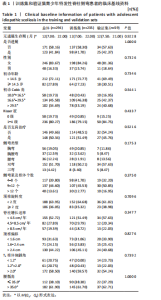
2.3 AIS患者基本情况及侧弯进展情况 此次研究共纳入符合标准的AIS患者294例,总体进展率为41.84%。按8∶2随机拆分为训练集和验证集,其中训练集235例,验证集59例。两组无进展生存期中位数分别为12.00(7.00,22.00)个月和12.00(7.50,21.00)个月,训练集和验证集AIS患者的基线资料相比,差异均无显著性意义(P > 0.05),见表1。 2.4 基于LASSO 回归的影响因素筛选 LASSO回归结果中,系数不为0的变量分别是初诊年龄、初诊Cobb角、是否支具治疗、Risser征、顶椎旋转度、脊柱增长速率、顶椎偏移、T1椎体倾斜角,见图2。 2.5 AIS患者侧弯进展的多因素Cox分析 LASSO回归初步筛选的8个变量的方差膨胀因子值均小于5,表明这些预测因素不存在多重共线性。Schoenfeld残差检验显示P > 0.05,表明各变量均满足PH假定。多因素Cox回归结果显示:初诊年龄、初诊Cobb角、是否支具治疗、Risser征、顶椎旋转度、脊柱增长速率、顶椎偏移、T1椎体倾斜角是侧弯进展的独立影响因素,差异有显著性意义(P < 0.1),见图3。 2.6 列线图模型的构建 考虑到临床普遍认为初诊年龄和Risser征呈正相关,为了避免潜在的相关性,此次研究在最终预测模型中将初诊年龄排除,使用初诊Cobb角、是否支具治疗、Risser征、顶椎旋转"
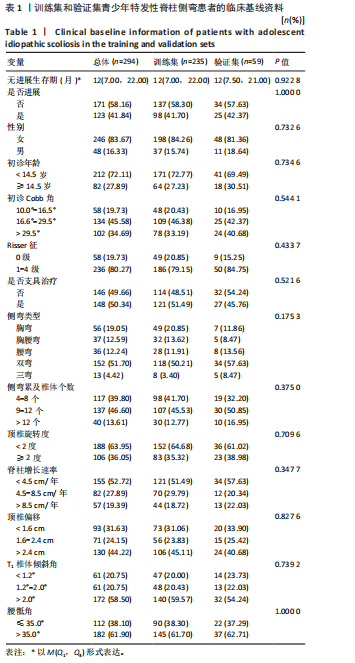
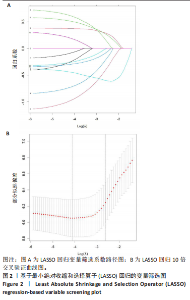
2.7 列线图模型的验证与评估 使用似然比检验对模型整体有效性进行分析,结果表明,似然比检验P值为0.000(P < 0.05),构建的列线图模型有意义。如图5时间依赖性ROC曲线显示,训练集和验证集6,12,18,24个月的AUC值分别为:0.731(95%CI:0.625-0.836),0.852(95%CI:0.791-0.912),0.855(95%CI:0.793-0.916),0.843(95%CI:0.767-0.918)和0.766(95%CI:0.622-0.910),0.850(95%CI:0.730-0.971),0.850(95%CI:0.715-0.985),0.830(95%CI:0.669-0.990);C-index分别为0.795(95%CI:0.773-0.817)和0.771(95%CI:0.714-0.827),模型区分度好。 以Bootstrap(B=1 000)抽样法绘制模型校准曲线,实际观察结果与列线图模型预测结果高度一致,表明模型拟合度好,预测准确度高(图6)。以净获益率为纵坐标,风险阈值为横坐标,绘制决策分析曲线,None线代表对所有患者均不做干预,净获益为0,All线代表对所有患者均进行干预,净获益为一条斜率为负的曲线,若决策分析曲线位于两线之上时,代表在该阈值概率下,使用模型将带来额外净收益。结果显示,在不同的时点模型表现略有差别,训练集和验证集6,12,18,24个月的风险阈值概率分别在0-20%,0-60%,10%-75%,20%-100%和10%-100%,10%-100%,10%-100%,10%-100%之间,使用此模型可使患者的净受益率增加(图7),表明该模型具有良好的临床应用价值。"
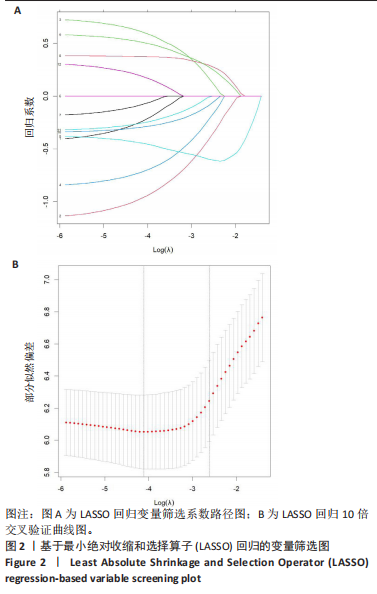
| [1] NEGRINI S, DONZELLI S, AULISA AG, et al. 2016 SOSORT guidelines: orthopaedic and rehabilitation treatment of idiopathic scoliosis during growth. Scoliosis Spinal Disord. 2018;13:3. [2] SUNG S, CHAE HW, LEE HS, et al. Incidence and Surgery Rate of Idiopathic Scoliosis: A Nationwide Database Study. Int J Environ Res Public Health. 2021;18(15):8152. [3] SELEVICIENE V, CESNAVICIUTE A, STRUKCINSKIENE B, et al. Physiotherapeutic Scoliosis-Specific Exercise Methodologies Used for Conservative Treatment of Adolescent Idiopathic Scoliosis, and Their Effectiveness: An Extended Literature Review of Current Research and Practice. Int J Environ Res Public Health. 2022;19(15):9240. [4] LI M, NIE Q, LIU J, et al. Prevalence of scoliosis in children and adolescents: a systematic review and meta-analysis. Front Pediatr. 2024;12:1399049. [5] MITSIAKI I, THIRIOS A, PANAGOULI E, et al. Adolescent Idiopathic Scoliosis and Mental Health Disorders: A Narrative Review of the Literature. Children (Basel). 2022;9(5):597. [6] GROSSMAN DC, CURRY SJ, OWENS DK, et al. Screening for Adolescent Idiopathic Scoliosis: US Preventive Services Task Force Recommendation Statement. JAMA. 2018;319(2):165-172. [7] SARKOVICH S, LEONARDI C, DARLOW M, et al. Back pain in adolescent idiopathic scoliosis: frequency and risk factors. Spine Deform. 2024; 12(5):1319-1327. [8] 徐帅, 苏永佳, 王振波, 等. 中国大陆中小学生脊柱侧凸的患病特点:关于72项研究的Meta分析[J]. 中国脊柱脊髓杂志,2021, 31(10):901-910. [9] 儿童青少年脊柱弯曲异常防控技术指南编写组, 马军. 《儿童青少年脊柱弯曲异常防控技术指南》解读[J]. 中国学校卫生,2022, 43(2):165-170+175. [10] 马钰, 汪南, 罗进玉, 等. 宁夏地区9-24岁学生脊柱认知现状与行为生活方式的相关性[J]. 宁夏医科大学学报,2024,46(1):60-63+70. [11] DI FELICE F, ZAINA F, DONZELLI S, et al. The Natural History of Idiopathic Scoliosis During Growth: A Meta-Analysis. Am J Phys Med Rehabil. 2018;97(5):346-356. [12] 沈洁. 女性特发性脊柱侧弯进展影响因素分析及预测模型研究[D]. 上海:上海体育学院,2021:1-73. [13] 康晓霞, 肖斌, 刘名名. 青少年特发性脊柱侧凸患者支具治疗后功能性动作特征及疗效影响因素列线图预测模型的建立[J]. 中国脊柱脊髓杂志,2024,34(1):20-30. [14] KOLIN DA, THOMPSON GH, BLUMENSCHEIN LA, et al. Providence Bracing: Predicting the Progression to Surgery in Patients With Braced Idiopathic Scoliosis. J Pediatr Orthop. 2023;43(8):e643-e648. [15] LI L, WONG MS. The application of machine learning methods for predicting the progression of adolescent idiopathic scoliosis: a systematic review. Biomed Eng Online. 2024;23(1):80. [16] WANG H, ZHANG T, ZHANG C, et al. An intelligent composite model incorporating global / regional X-rays and clinical parameters to predict progressive adolescent idiopathic scoliosis curvatures and facilitate population screening. EBioMedicine. 2023;95:104768. [17] DUFVENBERG M, CHARALAMPIDIS A, DIARBAKERLI E, et al. Prognostic model development for risk of curve progression in adolescent idiopathic scoliosis: a prospective cohort study of 127 patients. Acta Orthop. 2024;95:536-544. [18] 罗林威, 储振涛, 沈树锋, 等. 青少年特发性脊柱侧弯曲线进展相关危险因素的研究进展 [J]. 浙江医学,2024,46(13):1438-1442. [19] LENZ M, OIKONOMIDIS S, HARLAND A, et al. Scoliosis and Prognosis-a systematic review regarding patient-specific and radiological predictive factors for curve progression. Eur Spine J. 2021;30(7):1813-1822. [20] HUNG VWY, QIN L, CHEUNG CSK, et al. Osteopenia: a new prognostic factor of curve progression in adolescent idiopathic scoliosis. J Bone Joint Surg Am. 2005;87(12):2709-2716. [21] DAVIES E, NORVELL D, HERMSMEYER J. Efficacy of bracing versus observation in the treatment of idiopathic scoliosis. Evid Based Spine Care J. 2011;2(2):25-34. [22] KARAVIDAS N. Bracing In The Treatment Of Adolescent Idiopathic Scoliosis: Evidence To Date. Adolesc Health Med Ther. 2019;10:153-172. [23] WONG C, ANDERSEN TB. Evaluation of Brace Treatment Using the Soft Brace Spinaposture: A Four-Years Follow-Up. J Clin Med. 2022;11(1):264. [24] CHARALAMPIDIS A, DIARBAKERLI E, DUFVENBERG M, et al. Night time Bracing or Exercise in Moderate-Grade Adolescent Idiopathic Scoliosis: A Randomized Clinical Trial. JAMA Netw Open. 2024;7(1):e2352492. [25] TANG S, CHEUNG JPY, CHEUNG PWH. Effectiveness of bracing to achieve curve regression in adolescent idiopathic scoliosis. Bone Joint J. 2024;106-B(3):286-292. [26] 张臻, 张迦琅, 冯铭哲, 等. 支具治疗青少年特发性脊柱侧凸的研究进展[J]. 骨科,2023,14(1):87-91. [27] DEL PRETE CM, TARANTINO D, VIVA MG, et al. Spinal Orthosis in Adolescent Idiopathic Scoliosis: An Overview of the Braces Provided by the National Health Service in Italy. Medicina (Kaunas). 2023;60(1):3. [28] MODI HN, SUH SW, YANG JH, et al. Spontaneous regression of curve in immature idiopathic scoliosis - does spinal column play a role to balance? An observation with literature review. J Orthop Surg Res. 2010;5:80. [29] WONG LPK, CHEUNG PWH, CHEUNG JPY. Curve type, flexibility, correction, and rotation are predictors of curve progression in patients with adolescent idiopathic scoliosis undergoing conservative treatment: a systematic review. Bone Joint J. 2022;104-B(4):424-432. [30] RAJASEKARAN S, ANAND K, SHETTY A. Etiology and natural history of adolescent idiopathic scoliosis: A review. Indian Spine J. 2020;3:131. [31] YOO YJ, PARK JG, JO L, et al. Factors Influencing the Progression and Direction of Scoliosis in Children with Neurological Disorders. Children (Basel). 2022;9(1):81. [32] CHAZONO M, TANAKA T, MARUMO K, et al. Significance of peak height velocity as a predictive factor for curve progression in patients with idiopathic scoliosis. Scoliosis. 2015;10(Suppl 2):S5. [33] 李富丽, 张书豪, 王帅, 等. 青少年特发性脊柱侧凸患者病情进展影响因素的研究进展[J]. 广西医学,2022,44(17):2031-2035. [34] LARA T, ASTUR N, JONES TL, et al. The Risk of Curve Progression and Surgery in African Americans With Adolescent Idiopathic Scoliosis. Spine Deform. 2017;5(4):250-254. [35] DOLAN LA, WEINSTEIN SL, ABEL MF, et al. Bracing in Adolescent Idiopathic Scoliosis Trial (BrAIST): Development and Validation of a Prognostic Model in Untreated Adolescent Idiopathic Scoliosis Using the Simplified Skeletal Maturity System. Spine Deform. 2019;7(6):890-898 e894. [36] AULIA TN, DJUFRI D, GATAM L, et al. Etiopathogenesis of adolescent idiopathic scoliosis (AIS): Role of genetic and environmental factors. Narra J. 2023;3(3):e217. [37] 刘小梅, 王艳洋, 刘敏, 等. 青少年特发性脊柱侧凸进展风险的表观遗传学因素研究进展 [J]. 重庆医学,2024,53(9):1401-1405,1411. [38] LUO CL, MA CZH, ZOU YY, et al. Associations between spinal flexibility and bracing outcomes in adolescent idiopathic scoliosis: a literature review. J Orthop Surg Res. 2023;18(1):955. [39] CHEUNG JPY, CHEUNG PWH. Supine flexibility predicts curve progression for patients with adolescent idiopathic scoliosis undergoing underarm bracing. Bone Joint J. 2020;102-B(2):254-260. |
| [1] | Liao Long, Zhao Zepeng, Li Zongyuan, Yu Qinglong, Zhang Tao, Tang Jinyuan, Ye Nan, Xu Han, Shi Bo. Establishment and validation of a model for femoral head necrosis after internal fixation of femoral neck fracture using logistic regression and SHAP analysis [J]. Chinese Journal of Tissue Engineering Research, 2026, 30(3): 626-633. |
| [2] | Wang Zhipeng, Zhang Xiaogang, Zhang Hongwei, Zhao Xiyun, Li Yuanzhen, Guo Chenglong, Qin Daping, Ren Zhen. A systematic review of application value of machine learning to prognostic prediction models for patients with lumbar disc herniation [J]. Chinese Journal of Tissue Engineering Research, 2026, 30(3): 740-748. |
| [3] | Yu Weijie, Cao Dongdong, Guo Tianci, Niu Puyu, Yang Jialin, Wang Simin, Liu Aifeng. Risk prediction models of recurrence after percutaneous endoscopic lumbar discectomy: a systematic review and meta-analysis [J]. Chinese Journal of Tissue Engineering Research, 2026, 30(3): 749-759. |
| [4] | Huang Fengqin, Hu Yalin, Yang Boyin, Luo Xingmei. Constructing a risk prediction nomogram model for cognitive impairment in hypertensive intracerebral hemorrhage [J]. Chinese Journal of Tissue Engineering Research, 2026, 30(10): 2466-2474. |
| [5] | Xing Cong . Fatigue induction protocols for the lumbar extensor muscles [J]. Chinese Journal of Tissue Engineering Research, 2026, 30(10): 2515-2524. |
| [6] | Wang Rongqiang, Yang Liu, Wu Xiangkun, Shang Lilin. Analysis of factors associated with prognosis of osteoporosis patients after hip arthroplasty and construction of Nomogram prediction model [J]. Chinese Journal of Tissue Engineering Research, 2025, 29(33): 7137-7142. |
| [7] | Abuduainijiang·Abulimiti, Alimu·Mamuti, Li Simi. Artificial femoral head replacement for femoral neck fracture in the elderly: validation of a risk prediction model for hip dysfunction [J]. Chinese Journal of Tissue Engineering Research, 2025, 29(33): 7143-7149. |
| [8] | Li Jing, Lu Guangqi, Zhuang Minghui, Cui Ying, Yu Zhangjingze, Sun Xinyue, Ma Mingming, Zhu Liguo, Yu Jie. Development of a clinical prediction model for cervical instability in young and middle-aged adults based on machine learning [J]. Chinese Journal of Tissue Engineering Research, 2025, 29(33): 7203-7210. |
| [9] | Xu Zhi, Chen Yundong, Sun Yujie, Gong Xiaonan, Li Yuwan. Data of spinal osteosarcoma patients in United States based on SEER database: construction and validation of a prediction model for treatment outcomes and prognosis [J]. Chinese Journal of Tissue Engineering Research, 2025, 29(30): 6583-6590. |
| [10] | Zhu Xuekun, Liu Heng, Feng Hui, Gao Yunlong, Wen Lei, Cai Xiaosong, Zhao Ben, Zhong Min. Identification of core genes of osteoarthritis by bioinformatics [J]. Chinese Journal of Tissue Engineering Research, 2025, 29(3): 637-644. |
| [11] | Tu Zesong, Xu Daxing, Luo Hongbin, Wang Yusheng, Feng Xinglun, Peng Zhonghua, Du Shaolong. Construction of a risk prediction model for failure of proximal femoral nail antirotation fixation in intertrochanteric fractures [J]. Chinese Journal of Tissue Engineering Research, 2025, 29(27): 5845-5853. |
| [12] | Wu Yingkai, Shi Gaolong, Xie Zonggang . Weighted gene co-expression network analysis and machine learning identification of key genes in rheumatoid arthritis synovium [J]. Chinese Journal of Tissue Engineering Research, 2025, 29(2): 294-301. |
| [13] | Xu Daxing, Tu Zesong, Ji Muqiang, Xu Weipeng, Niu Wei. Machine learning prediction of the risk of secondary screw perforation after plate internal fixation for proximal humerus fractures [J]. Chinese Journal of Tissue Engineering Research, 2025, 29(15): 3179-3187. |
| [14] | Xu Wenbo, Wang Lihe, Li Songwei, Shi Pengbo. Establishment and validation of a Nomogram prediction model for risk factors of osteonecrosis of the femoral head in systemic lupus erythematosus [J]. Chinese Journal of Tissue Engineering Research, 2025, 29(15): 3215-3226. |
| [15] | Zhou Chao, Yu Guangyu, Yang Shaohua, Gao Leilei, Jin Zhen, Jiang Yueyuan, Li Huan. Prediction model and verification of sperm DNA fragments based on traditional Chinese medicine syndrome and semen quality-related parameters [J]. Chinese Journal of Tissue Engineering Research, 2025, 29(13): 2661-2668. |
| Viewed | ||||||
|
Full text |
|
|||||
|
Abstract |
|
|||||
